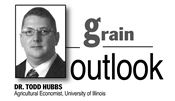|
Acreage Prospects For 2018

Corn and soybean prices have weathered the USDA’s November Crop Production report that contained larger forecasts of the size of the 2017 harvest, relative to market expectations, for both crops. Considerable speculation will occur over the next few months about the acreage decisions farmers will make in 2018. Current market conditions appear to support moderate soybean and corn acreage expansion in 2018.
Projecting the acreage allocations for 2018 U.S. crops will begin in earnest after the turn of the new calendar year. Prospects for 2018 crop acreage levels start with expectations about planted acreage for principal crops. Since planted acreage varies substantially from year to year, anticipating total planted acreage is quite difficult. In 2017, acreage planted in principal field crops declined to 318.2 million acres, the lowest level since 2011. The decrease in principal field crop acreage was particularly acute in the northern and southern plains. Texas and Kansas both decreased acreage by over 500,000 acres. North and South Dakota also decreased planted acreage by 143,000 and 279,000 acres respectively. Nebraska was the lone exception with an increase of 202,000 planted acres. While Illinois decreased planted acreage by 163,000 acres, most of the major Corn Belt states increase planted acreage in 2017. As we move into 2018, the prospect of large decreases in crop acreage in the Corn Belt appears low, while acreage changes in the plains may be in the form of crop adjustments instead of acreage losses.
In conjunction with the decrease in total principal crop planted acreage, prevented planting acreage was relatively low in 2017. The Farm Service Agency reports 2.4 million acres of prevented plantings in 2017, down from 3.7 million in 2016 and 6.7 million in 2016. Conservation Reserve Program acreage appears set to remain near 23.4 million acres. The current low price environment across most field crops point to steady or slightly lower total planted acreage in 2018 but holds the potential for more soybean and corn acres.
In 2017, the combination of corn and soybean acres increased to 179.9 million planted acres, expanding to 56.5 percent of principal crop acres. While corn and soybean acreage in total continued a three-year trend of increased planted acres, the change in soybean acreage stood out in 2017 with expansion to 89.5 million planted acres. Other than soybeans, the only major crops to see any planted acreage increases in 2017 were cotton, rye, peanuts, and canola. In the main corn producing states during 2017, only Kansas, Michigan, and North Dakota increased corn acreage over 2016 planting decisions. Increased planting of soybean acreage was common across all major producing states. North Dakota and Kansas lead the way in soybean acreage growth with 1.15 million and 700 thousand acres respectively. The increased soybean acreage, and in some instances corn acreage, came at the expense of other field crops with wheat acreage losing over 5.5 million acres from 2016 to 2017. The continuation of corn and soybean acreage expansion depends on demand prospects during the 2017-18 marketing year and the evolution of corn and soybean prices between now and planting.
Currently, demand prospects for corn remain mixed. Current demand is very strong for corn use in ethanol as production continues to exceed the pace of a year ago. The growth of livestock numbers and supportive prices in many livestock sectors provides support for increased feed demand. An indication of feed use for this marketing year will be available with the December 1 Grain Stocks report on January 12. Corn exports currently lag behind last year's pace with export inspections through November 23 trailing last year's total by 209 million bushels. When combined with the trade policy uncertainty associated with NAFTA, developments in the corn export market could inject volatility into corn prices in 2018. Additionally, the 7.2 million acres of corn to be planted in Brazil saw a large portion of the prospective acreage pushed back to the second crop which is more susceptible to the dry season. A reduction in Brazilian corn production may help corn exports in 2018.
For soybeans, the pace of the domestic crush is off to a strong start in the first two months of the marketing year. Soybean exports appear to be set for a strong marketing year but currently trail last year’s pace. Export inspections through November 23 lag last year’s pace by 120 million bushels. The current soybean crop being planted in South America will be a major factor in determining whether U.S. soybean exports hit record highs this marketing year.
The market will continue to form expectations about acreage devoted to corn and soybean acres. Preliminary surveys of farmer's planting intentions for 2018 have varied on the direction and magnitude of soybean and wheat acreage. Thus far, all surveys have indicated an expansion of corn acreage. Current market prices imply, at a minimum, a repeat of the soybean acreage planted in 2017. The prospect of corn and soybean acres seeing moderate expansions is possible in 2018. Data availability on acreage prospects in 2018 begins with the USDA's January 12 Winter Wheat Seedings report and will be followed by the March 30 Prospective Plantings report. ∆
DR. TODD HUBBS: Agricultural Economist, University of Illinois
|
|